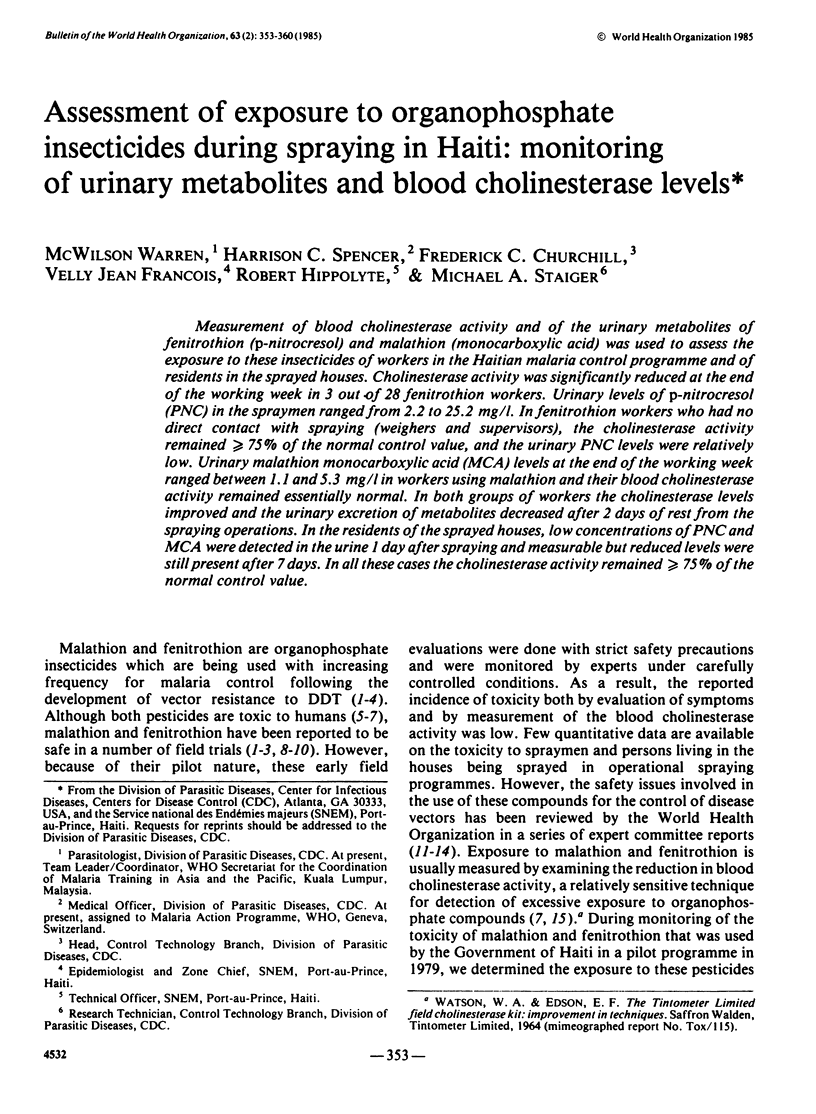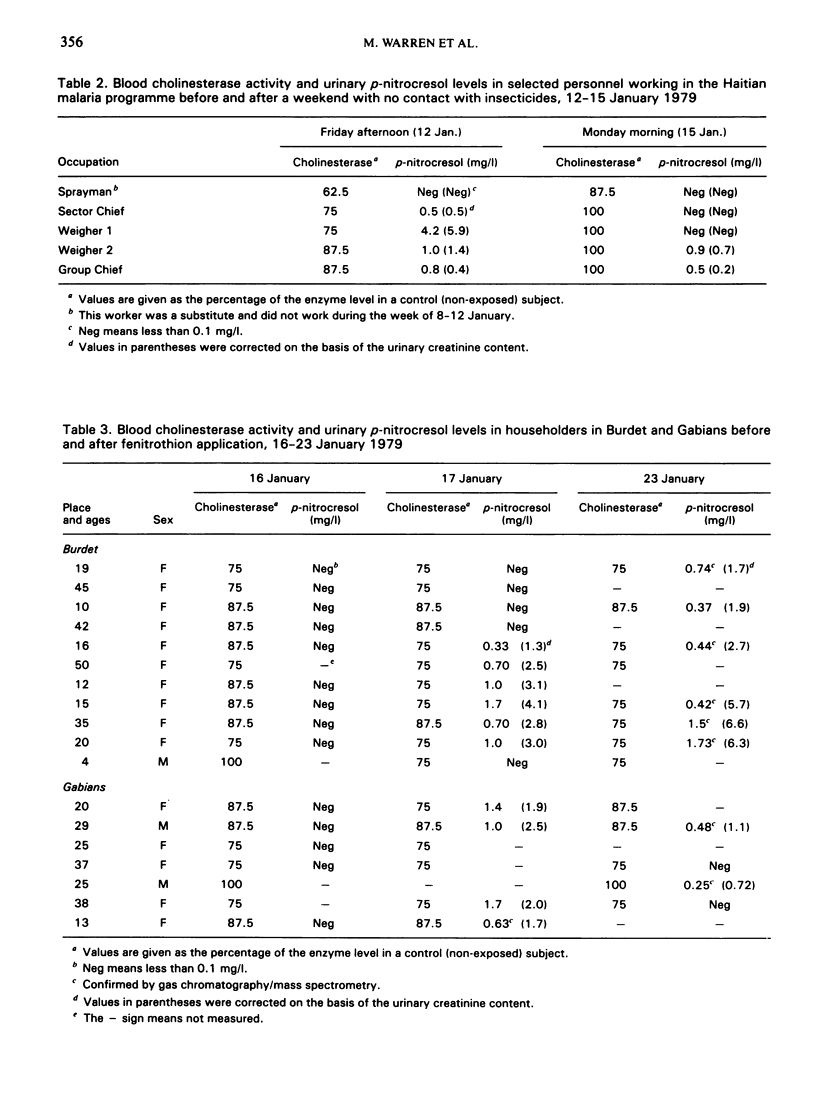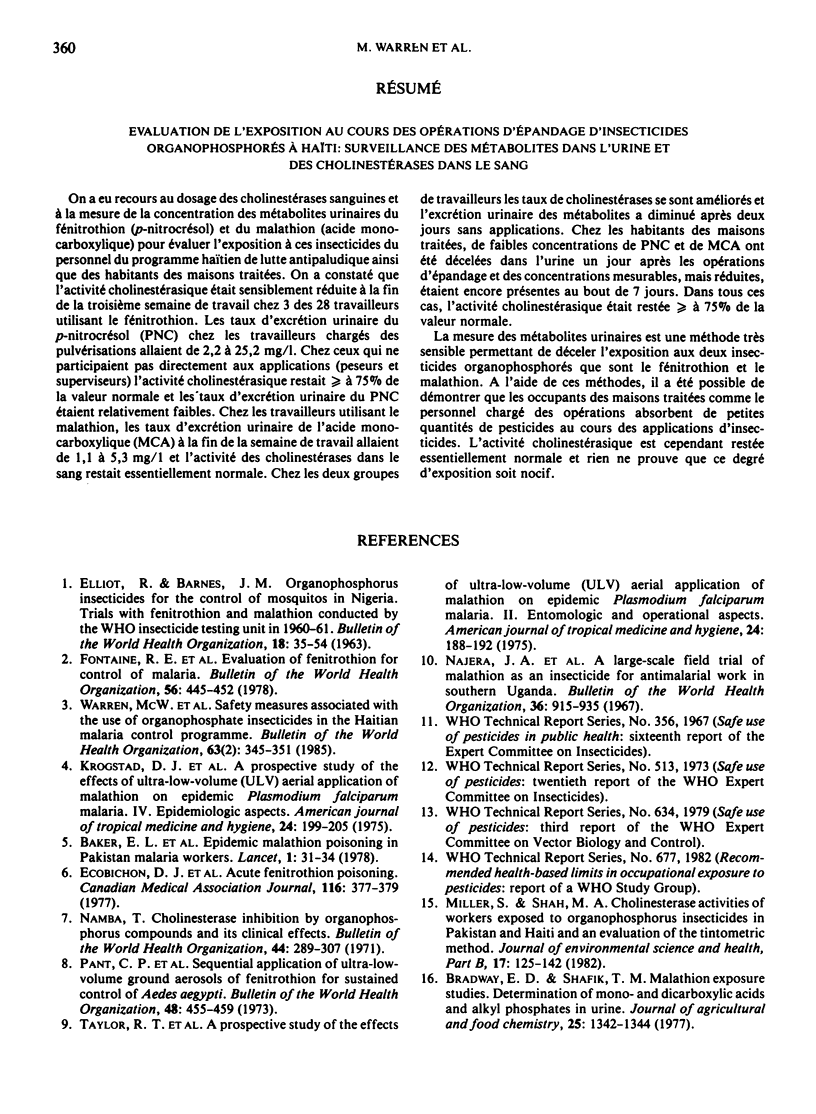Abstract
Measurement of blood cholinesterase activity and of the urinary metabolites of fenitrothion (p-nitrocresol) and malathion (monocarboxylic acid) was used to assess the exposure to these insecticides of workers in the Haitian malaria control programme and of residents in the sprayed houses. Cholinesterase activity was significantly reduced at the end of the working week in 3 out of 28 fenitrothion workers. Urinary levels of p-nitrocresol (PNC) in the spraymen ranged from 2.2 to 25.2 mg/l. In fenitrothion workers who had no direct contact with spraying (weighers and supervisors), the cholinesterase activity remained ≥ 75% of the normal control value, and the urinary PNC levels were relatively low. Urinary malathion monocarboxylic acid (MCA) levels at the end of the working week ranged between 1.1 and 5.3 mg/l in workers using malathion and their blood cholinesterase activity remained essentially normal. In both groups of workers the cholinesterase levels improved and the urinary excretion of metabolites decreased after 2 days of rest from the spraying operations. In the residents of the sprayed houses, low concentrations of PNC and MCA were detected in the urine 1 day after spraying and measurable but reduced levels were still present after 7 days. In all these cases the cholinesterase activity remained ≥ 75% of the normal control value.
Full text
PDF







Selected References
These references are in PubMed. This may not be the complete list of references from this article.
- Baker E. L., Jr, Warren M., Zack M., Dobbin R. D., Miles J. W., Miller S., Alderman L., Teeters W. R. Epidemic malathion poisoning in Pakistan malaria workers. Lancet. 1978 Jan 7;1(8054):31–34. doi: 10.1016/s0140-6736(78)90375-6. [DOI] [PubMed] [Google Scholar]
- Bradway D. E., Shafik T. M. Malathion exposure studies. Determination of mono- and dicarboxylic acids and alkyl phosphates in urine. J Agric Food Chem. 1977 Nov-Dec;25(6):1342–1344. doi: 10.1021/jf60214a002. [DOI] [PubMed] [Google Scholar]
- Ecobichon D. J., Ozere R. L., Reid E., Crocker J. F. Acute fenitrothion poisoning. Can Med Assoc J. 1977 Feb 19;116(4):377–379. [PMC free article] [PubMed] [Google Scholar]
- Fontaine R. E., Pull J. H., Payne D., Pradhan G. D., Joshi G. P., Pearson J. A., Thymakis M. K., Camacho M. E. Evaluation of fenitrothion for the control of malaria. Bull World Health Organ. 1978;56(3):445–452. [PMC free article] [PubMed] [Google Scholar]
- Krogstad D. J., Joseph V. R., Newton L. H. A prospective study of the effects of ultralow volume (ULV) aerial application of malathion on epidemic Plasmodium falciparum malaria. IV. Epidemiologic aspects. Am J Trop Med Hyg. 1975 Mar;24(2):199–205. doi: 10.4269/ajtmh.1975.24.199. [DOI] [PubMed] [Google Scholar]
- Miller S., Shah M. A. Cholinesterase activities of workers exposed to organophosphorus insecticides in Pakistan and Haiti and an evaluation of the tintometric method. J Environ Sci Health B. 1982;17(2):125–142. doi: 10.1080/03601238209372307. [DOI] [PubMed] [Google Scholar]
- Najera J. A., Shidrawi G. R., Gibson F. D., Stafford J. S. A large-scale field trial of malathion as an insecticide for antimalarial work in Southern Uganda. Bull World Health Organ. 1967;36(6):913–935. [PMC free article] [PubMed] [Google Scholar]
- Namba T. Cholinesterase inhibition by organophosphorus compounds and its clinical effects. Bull World Health Organ. 1971;44(1-3):289–307. [PMC free article] [PubMed] [Google Scholar]
- Pant C. P., Nelson M. J., Mathis H. L. Sequential application of ultra-low-volume ground aerosols of fenitrothion for sustained control of Aedes aegypti. Bull World Health Organ. 1973;48(4):455–459. [PMC free article] [PubMed] [Google Scholar]
- Taylor R. T., Solis M., Weathers D. B., Taylor J. W. A prospective study of the effects of ultralow volume (ULV) aerial application of malathion on epidemic Plasmodium falciparum malaria. II. Entomologic and operational aspects. Am J Trop Med Hyg. 1975 Mar;24(2):188–192. doi: 10.4269/ajtmh.1975.24.188. [DOI] [PubMed] [Google Scholar]
- Warren M., Ruebush T. K., 2nd, Hobbs J. H., Hippolyte R., Miller S. Safety measures associated with the use of organophosphate insecticides in the Haitian malaria control programme. Bull World Health Organ. 1985;63(2):345–351. [PMC free article] [PubMed] [Google Scholar]


